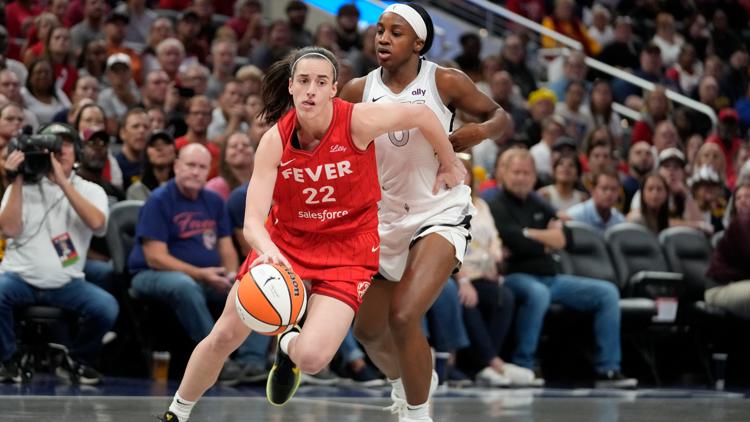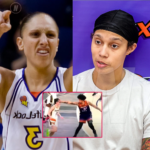The digital landscape erupted in controversy this week as a seemingly innocuous photograph featuring basketball phenom Caitlin Clark ignited a heated debate about racial insensitivity and unconscious bias.
The image, snapped during a casual moment at a recent public event, depicted Clark laughing alongside a group of friends.
The focal point of the ensuing firestorm became a prop held by one individual in the background: a small, vintage-style figurine, later identified by many online commentators as resembling racist caricatures historically used to demean Black people.
Clark, focused on her conversation in the foreground, appeared entirely unaware of the object behind her. Yet, within hours of the photo surfacing on social media, the narrative shifted dramatically.
Criticism flooded platforms like Twitter, Instagram, and TikTok. Users pointed to the figurine as an overt symbol of racism, expressing profound disappointment and anger that Clark, a prominent white athlete with a massive platform, would be photographed in proximity to it, even inadvertently.
The backlash was swift and severe, with accusations ranging from poor judgment and carelessness to implicit endorsement of racist imagery.
“How could she not notice?” and “This is the environment she’s comfortable in?” became common refrains. The context of the photo – a private gathering where Clark wasn’t handling the object – was largely drowned out by the visceral reaction to the figurine’s presence.
The controversy quickly transcended sports forums, tapping into broader, ongoing societal tensions surrounding race, historical trauma, and the responsibilities of public figures.
Commentators highlighted the painful history of such caricatures, used for decades to dehumanize Black people and perpetuate harmful stereotypes. For many, seeing such imagery, even passively in the background of a photo with a celebrated athlete like Clark, felt like a jarring and painful reminder of that enduring legacy.
The incident became framed within the larger conversation about microaggressions and the need for heightened awareness, particularly among white individuals in positions of influence, regarding symbols laden with racist history.
Facing the escalating storm, Clark and her representatives moved swiftly to address the situation. Within a day, a statement attributed to Clark was released through her management team.
It expressed deep regret for the pain caused, clarified that she had been completely unaware of the figurine’s presence or significance at the time the photo was taken, and unequivocally condemned racist imagery and stereotypes.
“I am horrified that my presence in that photo has been associated with something so abhorrent,” the statement read. “I was focused on the conversation in front of me and genuinely did not see the object in the background.
I understand now the deep hurt these symbols cause, and I apologize unreservedly to anyone who was offended or triggered by seeing that image. I stand firmly against racism in all its forms.” The statement emphasized her commitment to learning and being more vigilant.
Reaction to Clark’s apology was predictably mixed. Some accepted her explanation at face value, acknowledging the photo’s accidental nature and praising her prompt and unequivocal response.
Supporters argued that condemning someone for an object in their peripheral vision, entirely outside their focus or control, constituted an unfair overreaction and a dangerous precedent. Others, however, remained skeptical.

Critics questioned how such an object could be present in her social circle without her knowledge, suggesting it pointed to a lack of awareness or sensitivity within her environment, for which she still bore some responsibility.
They argued that her immense privilege as a white superstar inherently required a greater duty of care regarding racial issues, and that ignorance, even if genuine, wasn’t a complete excuse.
The incident inevitably drew responses from fellow athletes and sports commentators. Some prominent Black athletes expressed weariness, noting the frequency with which such controversies arise and the emotional toll of constantly explaining why certain symbols are harmful.
Others offered measured takes, acknowledging the accidental nature of the photo while stressing the importance of the conversation it sparked about historical context and awareness.
Several commentators pointed out the double standards often at play, questioning whether a Black athlete in a similar situation would have received the same initial benefit of the doubt or the same pathway to redemption as Clark.
The sports media landscape became a battleground for debating proportionality, intent versus impact, and the role of social media in amplifying outrage.
This episode underscores the intensely scrutinized environment in which modern athletes operate, where every captured moment can be dissected globally within seconds.
It highlights the challenge of navigating complex racial histories and the potent emotional resonance of symbols, even when encountered unintentionally.
For Clark, whose meteoric rise has been marked by record-breaking performances and largely positive coverage, this controversy represents her first significant encounter with widespread negative backlash.
It serves as a stark reminder of the weight carried by her platform and the heightened expectations placed upon public figures regarding social consciousness, particularly on issues of race. The speed and ferocity of the online reaction demonstrate how quickly a fleeting moment can spiral into a reputational crisis.
The debate also forces a critical examination of where the line lies between holding individuals accountable for harmful imagery and assigning blame for circumstances genuinely beyond their immediate perception.
Was the outrage directed at Clark justified as a necessary call for greater awareness and accountability among those with vast influence?
Or did it veer into the territory of disproportionate punishment for an unintended association, fueled by the outrage dynamics of social media? There are no easy answers, as perspectives are deeply informed by individual experiences with racism and the weight assigned to historical symbols.

The incident forces a confrontation with uncomfortable questions about unconscious bias, the environments we inhabit, and the shared responsibility to recognize and reject hateful iconography, even when it surfaces unexpectedly.
Ultimately, the long-term impact on Caitlin Clark’s career remains uncertain. Her on-court prowess is undeniable, and many fans are likely to separate the accidental photo controversy from her athletic achievements. Her swift apology may mitigate lasting damage for a significant portion of her fanbase.
However, for others, particularly within the Black community and among advocates for racial justice, the incident may leave a lingering stain, a reminder of the pervasive nature of racist symbols and the ease with which they can appear, unchallenged, in mainstream spaces.





